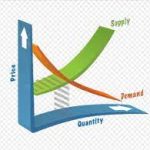There is a concept of accelerator which was not taken into account by Keynes has become popular after Keynes, especially in the discussions of theories of trade cycles and economic growth. The acceleration principle describes the effect quite opposite to that of multiplier.
According to this, when income or consumption increases, investment will increase by a multiple amount. When income and consumption of the people increases, a higher amount of the commodities needs to be produced. This will require more capital to produce them is the already given stock of capital is fully used.
Since in this case, investment is induced by changes in income or consumption this is known as induced investment. The accelerator is the numerical value of the relation between the increases in investment resulting from an increase in income. The net induced investment will be positive if national income increases and induced investment may fall to zero if the national income or output remains constant.
To produce a given amount of output, it requires a certain amount of capital. If Yt output is required to be produced and v is capital – output ratio, the required amount of capital to produce Yt output will be given by the succeeding equation:
Kt = v Yt ……Equation (1)
Where,
K stands for the stock of capital
Yt stands for the level of output or income and
v for capital – output ratio
This capital output ratio v is equal to K / Y and in the theory of accelerator this capital output ratio is assumed to be constant. Therefore, under the assumption of constant capital output ratio, changes in output are made possible by changes in the stock of capital. Thus, when income is Yt then required stock of capital Kt = v Yp.
When output or income is equal to Yt-1, then required stock of capital will be Kt-1 = vYt-1. it is clear from the above that when income increases from Kt-1 in period t-1 to Yt in period, t, then stock of capital will increase from Kt-1 to Kt. As seen above, Kt-1 is equal to vYt-1 and Kt is equal to vYp.
Hence, the increase in the stock of capital in period t is given by the following equation:
Kt – Kt-1 = vYt – vYt-1
Kt – Kt-1 = v(Yt – Yt-1) ……Equation (2)
Since, increase in stock of capital in a year (Kt – Kt-1) represents investment in that year, the above Equation (2) can be written as below:
It = v(Yt – Yt-1) …….Equation (3)
Equation (3) reveals that as a result of increase in income in any year t from a previous year t-1, increase in investment will be v times more than the increase in income.
Hence it is v i.e. capital output ratio which represents the magnitude of the accelerator. If the capital output ratio is equal to 3, then as a result of a certain increase in income, investment will increase three times more i.e. accelerator here will be equal to 3.
It thus follows that investment is a function of change in income. If income or output increases over time, which is when Yt is greater than Yt-1, then investment will be positive. If income declines that is Yt is less Yt-1 then disinvestment will take place. And if the income remains constant that is Yt = Yt-1, the investment will be equal to zero.


